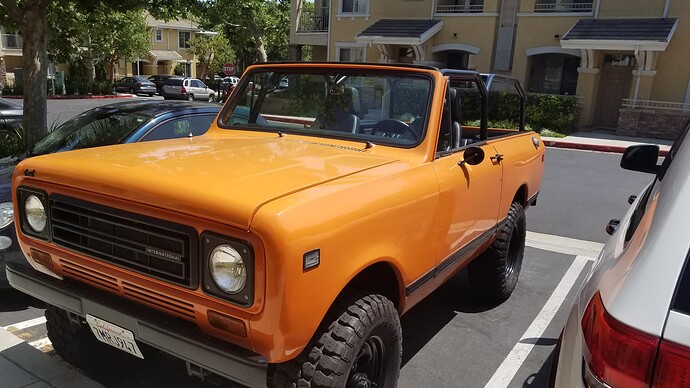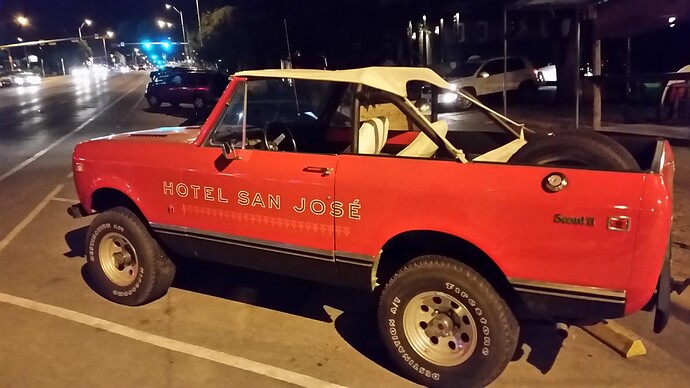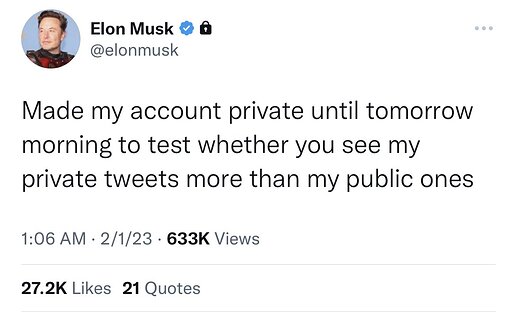Raise revenues by requiring Tesla Verified Driver Profiles
My first car was a '78 IH Scout 2.
That thing was a bonafide tank with tank like gas mileage, but fun to drive.
The top was removable as well- that was cool.
The Hotel San Jose here in Austin has a nicely restored Scout 2 that they own and usually keep in front of the property.
Mine was a ‘77 with an IH345 V8. Eight miles per gallon of genuine American steel!
I bought it for $2,800, drove the shit out of it and sold it for $1,000. Today I could probably get $15,000 for it. They go for stupid money in running condition. I miss it.
Yep, mine had that same engine.
It was a maroonish/rust color and I think my folks bought it for me for $2500 in spring '89 when I got my license. My brother got it later and we ended up selling it for pennies somewhere around '93.
I saw a beautifully restored one a neighbor had at my old apt complex when I lived in SoCal.
You’re right, Matt, they fetch a mighty nice price now if they’re restored nicely.
Wow, that’s a sweet ride.
Had to go dig up the pic i took of the one in front of Hotel San Jose from awhile ago.
They sell t shirts with the Scout on the front.
Sweet ride.
My hope for EVs is that batteries will get good enough and electricity will get cheap enough that “body on frame” or 'body on skateboard" designs like Ree will come that can support almost any body / vehicle style.
The opportunity is for small to medium modern-day “carriage” builders to remake the dull sameness on the modern car market. If the electricity is cheap and green, who cares about drag coefficients?
Drag impacts range and, right now, range anxiety is preventing an unknown number of people switching to EVs from ICEs.
Once we get over that collectively - because for most people it’s a once or twice a year issue - then we can revert to designing EVs for something other than being slippery.
Case in point: the Rivian delivery trucks built for Amazon have a range of about 150 miles. That was designed by Amazon because their “last mile” trucks don’t need any more than that, and they’re on the road almost all day.
This is probably the wrong place for this, but I don’t know where else to put it. I keep getting incessant emails from Chevron and Valero telling me I should use their phone app when filling my car and they’ll give me $0.08/gal or $0.10/gal or whatever discount for doing so. I don’t want to use their damn app just to fill my car up, but what I really can’t figure out is what benefit they’re deriving that’s compelling enough for them to offer a discount. They already know every time I fill up because I’m using their card, and they have my email address so they’re already bombarding me with their offers. What do they gain by spamming my phone too?
Maybe it increases the odds you’ll be ‘brand-loyal’ to their stations.
It’s to ensure you use their card. Huge stakes there. And, the marketers say they can cross-sell you (“Sale on Fritos Inside!”, etc)
Start with the assumption that, at worst, they’re breaking even by giving you the discount. (And that’s being pretty generous; these are oil companies after all.) Since filling up your tank is basically a zero-sum game, it’s more likely that they’re simply taking a little less profit to make sure you don’t give their competitors any profit. They’re also banking on you maybe forgetting to pay off the card every month and therefore getting to charge you interest.
This. They sell your info and usage patterns. Potential name + address is valuable on the open market. Verified name + address + verified e-mail address + location-specific buying patterns is an absolute gold mine.
I remember one of the majors pushing the cleaning agents in their gas: “Give us 5 tanks and you’ll see a difference”. Or…what? If you don’t see the difference, they’ve still sold you 5 tankfuls of gas.
Just a point of order, but it’s the credit card bank, not the oil company who is giving you the discount. Oil companies license their name to the cards, but have nothing to do with them after that. Banks/credit card companies offer you a discount because most people will run a balance on it and pay interest. Typically at a pretty high rate.
And as has been mentioned…the discount is to get you to use their card in hopes that you run a balance and pay interest on it.
So, sometime in 2025 then.
Maybe.
For my own edification, I priced out an F-150 Lightning last week. Ford’s website says the XLT is ~ $65k (for the build I was interested in).
One of the local dealerships has an XLT in inventory right now, almost identical to what I saw online. They want $85k for it.
It’s exaggerated for EVs, but dealers are charging over MSRP for most new cars right now. I don’t understand how that business model survives this. Ford already announced it’s going to be selling their electric models direct to the public.


